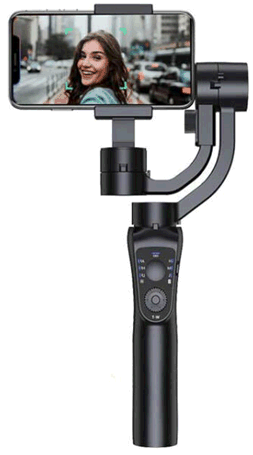-
Designing Single- and Three-Axis Selfie Sticks With MSPM0 MCUs SLAAEA2A February 2023 – September 2023 MSPM0G1105 , MSPM0G1106 , MSPM0G1107 , MSPM0G1505 , MSPM0G1506 , MSPM0G1507 , MSPM0G3105 , MSPM0G3106 , MSPM0G3107 , MSPM0G3505 , MSPM0G3506 , MSPM0G3507
-
Designing Single- and Three-Axis Selfie Sticks With MSPM0 MCUs
Designing Single- and Three-Axis Selfie Sticks With MSPM0 MCUs
Designing Single- and Three-Axis Selfie Sticks With MSPM0 MCUs
There are two main types of selfie stick products on the market: single-axis selfie sticks and three-axis selfie sticks. How can a selfie stick maintain the shooting stability of a mobile phone? Hand shaking of photographers can cause one-axis or three-axis jitter, in which the position and direction is detected by the built-in gyroscope sensor of the selfie stick. The internal MCU can process the data and drive one or three motors to produce the opposite movement, which is used to offset the vibration of the mobile phone screen and stabilize the phone when taking a picture or video.
 Figure 1 3-Axis Selfie Stick
Figure 1 3-Axis Selfie StickTo sense, process, and actuate the single- or three-axis motors in a gimbal or selfie stick application, TI’s MSPM0 MCUs can meet the requirements with high-performance features, portfolio, and diverse package sizes to fit small form factors.
 Figure 2 3-Axis and 1-Axis Selfie Stick
Block Diagram
Figure 2 3-Axis and 1-Axis Selfie Stick
Block DiagramHardware and software
Hardware
- Microcontroller (MCU): Acquires gyroscope or accelerator information, runs the control algorithms generates the PWM, and gets the motor speed and position information.
- Driver: BLDC integrated MOSFET motor driver
- Power system: Battery, battery charger, boost, and LDO regulator
Software
- Application: Task management and scheduling.
- Algorithm: Calculates the gesture of phone in real time according gyroscope or accelerometer feedback; drives BLDC motor using Hall-sensored trapezoidal or sensorless algorithm to achieve closed-loop position control.
All these functions can be realized using TI devices:
Why is MSPM0 considered for selfie sticks?
The newest Arm® Cortex® M0+ MSPM0Gx high-performance MCUs feature up to 80-MHz operating frequency, 32 kB to 128 kB flash options, scalable analog integration, advanced on-chip motor control peripherals provide a design for various selfie stick applications.

What can MSPM0 do in a selfie stick?
The following resources are available for selfie sticks:
- Motor control designs in MSPM0-SDK
- MSPM0 Sensored Trap Library
- Supports DRV831x devices with integrated current sense
- MSPM0 Sensorless FOC Library
- Supports DRV831x devices with integrated current sense
- MSPM0 Sensored Trap Library
- High-performance core integrated math accelerator (MATHACL)
- Reduce process time for FOC and gesture estimation algorithms and sensing signal
- Analog and digital peripherals for motor control
- Two independent 4-Msps 12-bit ADC modules: fast and accurate current sensing
- Two zero-drift chopper op-amps: accurately amplify the 2-phase current
- Three high speed comparators: enable hardware current limiting
- Advanced motor control timers: six flexible PWMs and cross triggers
- Communication interfaces
- SPI, UART, and I2C to connect to IMU (inertial measurement unit) sensor
 Figure 3 Selfie Stick System Block Diagram Based on MSPM0Gx
Figure 3 Selfie Stick System Block Diagram Based on MSPM0GxResources
Order an MSPM0 LaunchPad™ development kit and DRV8316REVM today to start evaluating MSPM0 for a motor control function for a gimbal or selfie stick system. Jump-start a design with MSPM0 code examples and interactive online trainings. The follow links provide resources that are available.
- MSPM0-SDK
- MSPM0 overview page
- MSPM0 Academy
- MSPM0 LaunchPad development kit
- DRV831xEVM
- MSPM0 Trapezoidal Control Application Note
- MSPM0 Sensorless FOC Application Note
- TI Precision Labs - Motor Drivers: Brushless-DC Basics